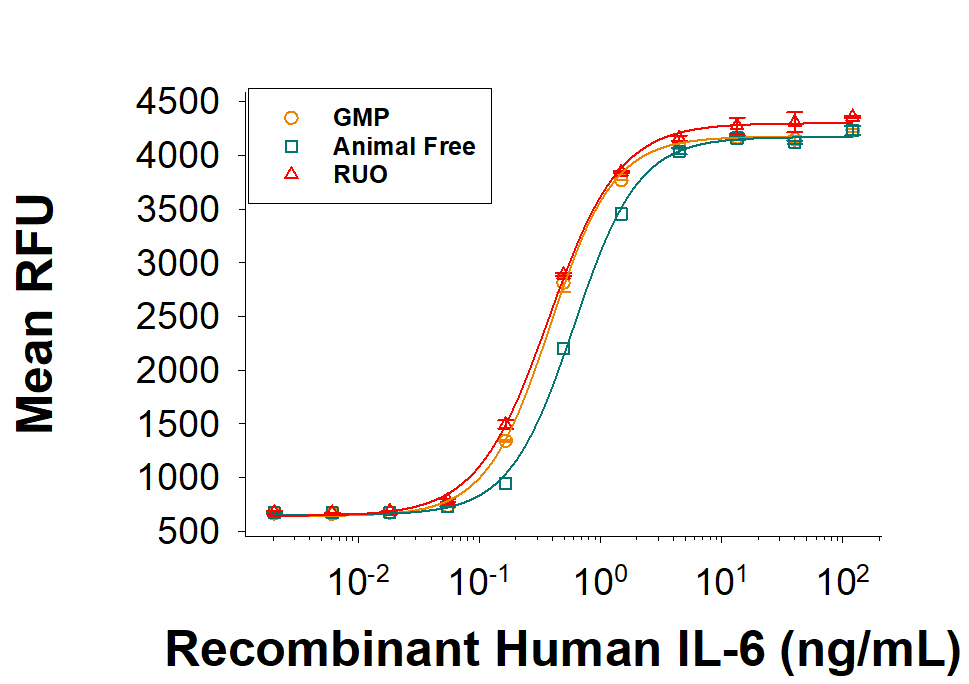Recombinant Human IL-6, Animal-Free Protein
R&D Systems, part of Bio-Techne | Catalog # AFL206
Intended for preclinical researchers who may transition to GMP IL-6 for their clinical work

Key Product Details
Learn more about Animal-Free Recombinant Proteins
Product Specifications
Source
E. coli-derived human IL-6 protein
Pro29-Met212
Produced using non-animal reagents in an animal-free laboratory.
Pro29-Met212
Produced using non-animal reagents in an animal-free laboratory.
Purity
>97%, by SDS-PAGE under reducing conditions and visualized by silver stain.
Endotoxin Level
<0.01 EU per 1 μg of the protein by the LAL method.
N-terminal Sequence Analysis
Pro29
Predicted Molecular Mass
20.9 kDa
Activity
Measured in a cell proliferation assay using T1165.85.2.1 mouse plasmacytoma cells. Nordan, R.P. et al. (1987) J. Immunol. 139:813.
The ED50 for this effect is 0.200‑0.800 ng/mL.
The specific activity of Recombinant Human IL-6 is >1.00 x 108 IU/mg, which is calibrated against the human IL‑6 WHO International Standard (NIBSC code: 89/548).
The ED50 for this effect is 0.200‑0.800 ng/mL.
The specific activity of Recombinant Human IL-6 is >1.00 x 108 IU/mg, which is calibrated against the human IL‑6 WHO International Standard (NIBSC code: 89/548).
Scientific Data Images for Recombinant Human IL-6, Animal-Free Protein
Formulation, Preparation and Storage
AFL206
| Formulation | Lyophilized from a 0.2 μm filtered solution in PBS and NaCl. |
| Reconstitution | Reconstitute at 0.2 mg/mL in sterile PBS. |
| Shipping | The product is shipped at ambient temperature. Upon receipt, store it immediately at the temperature recommended below. |
| Stability & Storage | Use a manual defrost freezer and avoid repeated freeze-thaw cycles.
|
Background: IL-6
References
- Mansell, A. and B.J. Jenkins (2013) Cytokine Growth Factor Rev. 24:249.
- Schuett, H. et al. (2009) Thromb. Haemost. 102:215.
- Erta, M. et al. (2012) Int. J. Biol. Sci. 8:1254.
- Garbers, C. et al. (2012) Cytokine Growth Factor Rev. 23:85.
- Mihara, M. et al. (2012) Clin. Sci. (Lond.) 122:143.
- Hirano, T. et al. (1986) Nature 324:73.
- Kestler, D.P. et al. (1995) Blood 86:4559.
- Kestler, D.P. et al. (1999) Am. J. Hematol. 61:169.
- Bihl, M.P. et al. (2002) Am. J. Respir. Cell Mol. Biol. 27:48.
- Alberti, L. et al. (2005) Cancer Res. 65:2.
- Murakami, M. et al. (1993) Science 260:1808.
- Muller-Newen, G. (2003) Sci. STKE 2003:PE40.
- Mitsuyama, K. et al. (2006) Clin. Exp. Immunol. 143:125.
- Cerutti, A. et al. (1998) J. Immunol. 160:2145.
Long Name
Interleukin 6
Alternate Names
BSF-2, BSF2, IFNB2, IL6, MGI-2A
Entrez Gene IDs
Gene Symbol
IL6
UniProt
Additional IL-6 Products
Product Documents for Recombinant Human IL-6, Animal-Free Protein
Manufacturing Specifications
Animal-Free Manufacturing ConditionsOur dedicated controlled-access animal-free laboratories ensure that at no point in production are the products exposed to potential contamination by animal components or byproducts. Every stage of manufacturing is conducted in compliance with R&D Systems' stringent Standard Operating Procedures (SOPs). Production and purification procedures use equipment and media that are confirmed animal-free.
Production
- All molecular biology procedures use animal-free media and dedicated labware.
- Dedicated fermentors are utilized in committed animal-free areas.
Purification
- Protein purification columns are animal-free.
- Bulk proteins are filtered using animal-free filters.
- Purified proteins are stored in animal-free containers in a dedicated cold storage room.
- Low Endotoxin Level.
- No impairment of biological activity.
- High quality product obtained under stringent conditions.
- For ex vivo research or bioproduction, additional documentation can be provided.
Product Specific Notices for Recombinant Human IL-6, Animal-Free Protein
For research use or further manufacturing only
